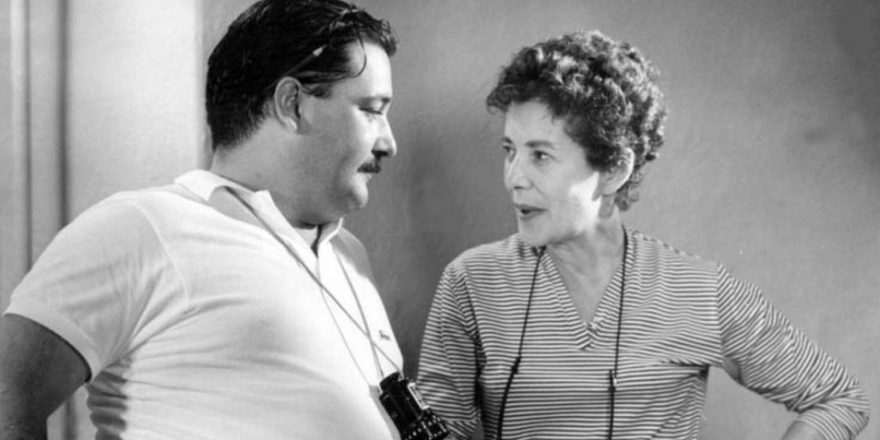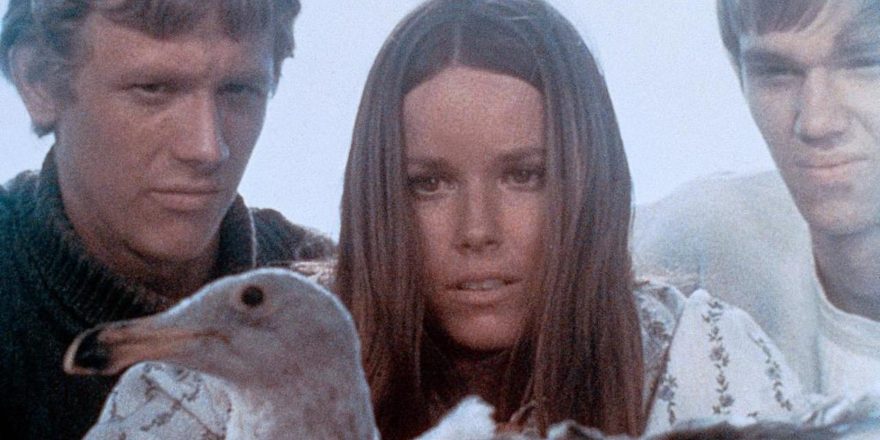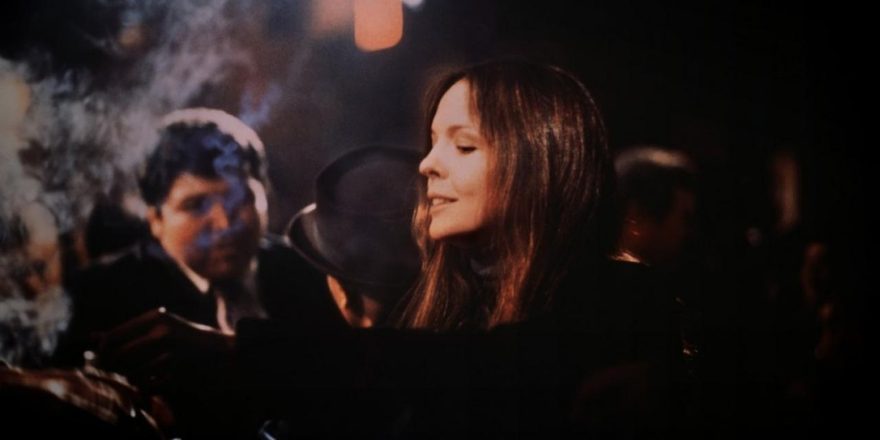Today we are double-dipping with two pieces by Bruce LaBruce on Frank and Eleanor Perry; go here to read LaBruce’s Academy of the Underrated column on the Perrys’ Last Summer.
Back before independent films became mere carbon copies of big budget studio pictures with all-star casts scaled down to more manageable means, before experimental filmic technique began to be regarded in America as either indulgently vain or willfully obtuse, before a picture made for well under a million dollars was still subject to test marketing and distributor interference, there was Frank and Eleanor Perry. Although the husband-and-wife director-writer team technically only produced one independently financed film outside of the Hollywood system – David and Lisa (1962), their breakthrough drama about a pair of mentally disturbed teenagers – they spent the remainder of the ’60s shuffling from studio to studio making modestly budgeted, right coast pictures that had a distinctively maverick, independent feel, as if the dyspeptic duo were thumbing their noses not only at Hollywood orthodoxy, but also at the very fabric of the ruling classes, woven of old money and new.
Like one of the ambitious, upwardly mobile characters of his movies, Frank Perry started his career as a parking lot attendant at the Westport Country Playhouse before eventually working his way up the ladder to theatrical producer. After serving his time first fighting in Korea, then producing television documentaries, he and his wife Eleanor, whom he had married in 1960, gained international recognition for David and Lisa, an earnest study of mental illness based on case studies by the psychiatrist Dr. Theodore Isaac Rubin. Screenwriter Eleanor Perry came by the subject matter naturally: she had earned a master’s degree in psychiatric social work at Western Reserve University in Cleveland while married to her first husband, a lawyer with whom she collaborated on several novels under the joint pseudonym Oliver Weld Bayer. Although David and Lisa is arguably less interesting and emotionally affecting than the subsequent movies also made in black-and-white and set in mental institutions that it no doubt inspired – John Cassavetes’ A Child is Waiting (1963), one of his rare studio pictures as director, and Robert Rossen’s Lilith (1964) – its frank treatment of mental illness, stark photography, and intense performances, particularly by the young, saucer-eyed Keir Dullea, turned it into the original independent phenomenon, making more than a million dollars worldwide and earning the Perrys’ dual Oscar nods.
After a couple of unremarkable projects, the Perrys finally found their footing in the late ’60s with a tart trilogy of pictures about the Northeastern gentry that remains the most incisive and caustic take on the privileged, over-indulged classes this side of Buñuel’s The Discreet Charm of the Bourgeoisie. Like David and Lisa, The Swimmer (1968), Last Summer (1969), and Diary of a Mad Housewife (1970) are each in their own way about madness: the kind that results from rigid social conventions, catered whims, and keeping up with the Joneses – or rather, the Rockefellers. In contrast to that other independent pioneer of the era, Cassavetes, whose frantic camera and improvisational temerity gravitated more toward freewheeling proletarian subjects, Perry’s mannered, studied style was more suited to the buttoned-down, status-conscious characters of the elite classes whose material worlds gate their desires. Both directors were almost obsessed with the subject of insanity – Cassavetes’ A Woman Under the Influence is like a working-class remake of Perry’s Diary of a Mad Housewife, for example – but whereas Cassavetes threw himself into the maelstrom of madness, both stylistically and thematically, Perry sat back and carefully observed his characters crack: the manic depressive versus the obsessive compulsive.
Some critics have mistaken Perry’s allegorical archness for camp (see, especially, Mommie Dearest), but that hardly does his pictures justice. (Like Joseph Losey, Perry draws class distinctions and archetypes so acutely that a certain camp boldness unavoidably creeps in.) The Swimmer, based on John Cheever’s rather long short story, concerns one Neddy Merrill (Burt Lancaster, who bravely spends the entire movie shivering in black bathing trunks), a wayward member of the New England country club set who ventures forth late one summer to swim, pool by pool, across the county. Most of Perry’s heroes are delusional, or self-delusional, and Neddy is no exception: his quest to swim back to a home that exists only in his mind masks the shambles that his life has become: his failure as an executive, a husband, and a father, his final gasping grasp at faded youth. Portaging along the Lucinda River, named after the wife he refuses to admit has divorced him, he runs into all manner of moneyed, bored and unsympathetic characters, from a pair of ageing, imperious nudists who might have posed for Diane Arbus to a gauntlet of bitchy socialites who nonetheless swoon over his still firm, tanned body.
Perry is always as interested in the offspring of the disaffected rich as he is in their parents – the doomed progeny who haven’t lost all of their innocence quite yet. Neddy convinces his nubile former babysitter to accompany him on his journey for a while before he allows his exuberance to descend into lechery and scares her off (dirty old men are always lurking in Perry pictures). Later he make-believe swims across a vast, empty pool with a poor little rich boy whose absent, jet-setting parents have left him to be raised by the maid. In one chilling scene, Neddy, after leaving the boy alone, hears the thwack thwack of the diving board and fears that the child may have mistaken make-believe for reality. When Neddy runs back and snatches him off the diving board in a panic, the boy thinks he’s nuts. He wasn’t going to dive into an empty pool. Such are the layers of fantasy and delusion in the Perry universe.
Neddy meets his nemesis in Shirley Abbott (Janice Rule), his former mistress, a chilly actress in a hot bathing suit who sits by the pool reading Films and Filming. In a series of painful exchanges amplified by a probing, intrusive camera (Perry always seems to move into tight, naked shots of body parts, eyes, folds of flesh – see also Diary of a Mad Housewife), the former lovers tear each other apart. Shirley accuses him of dumping her in an expensive restaurant because “you thought I wouldn’t dare make a fuss in front of all those mink hats, snobbish waiters and stylish fags” and reduces his wife to “that aging Vassar girl in her understated little suit.” In all the movies by the Perrys, the precise, cutting dialogue is inseparable from the similarly acute, invasive camera.
Before his final downfall, Neddy ends up in a public swimming pool where he is confronted by the local townspeople who own businesses to whom he still owes money. As acid-tongued as their rich overseers, they cut him down to size for being a deadbeat and for “letting his kids run around wrecking cars.” Witnessed by several more contemporary news items, such as the Lizzie Grubman incident, it appears that nothing much has changed.
Last Summer, based on the Evan Hunter novel, takes up where The Swimmer left off, concentrating on the misadventures of the teenage offspring of the very rich one summer in the Hamptons. The parents this time are largely absent, like the garbled off-screen adult voices in a Peanuts cartoon. Three handsome teens – Peter (Richard Thomas), Dan (Bruce Davison) and Sandy (Barbara Hershey) – find an injured seagull and decide to make it their summer project to nurse it back to health. Then they meet a young, innocent, slightly overweight girl named Rhoda (Catherine Burns) who hasn’t any friends, and she becomes their summer project. No film has ever captured so rapturously the desultory, sand-swept sensations of an endless teenage summer, drinking beer as truth serum under an impromptu tent on an overcast day at the beach, or lying languorously in the beating sun on a gently rocking sloop, confessing their deepest, darkest secrets.
But of course, this is a Perrys picture, so everything must finally go horribly wrong. After the two boys find the injured seagull in the woods with its neck broken (a crime to which Sandy confesses – it had bitten her, after all), the threesome smokes pot and washes each other’s hair, then invites Rhoda over to initiate her into their private world. After they force her to tell them something extremely personal, Rhoda relates the story of her mother’s death by drowning in a riveting monologue that justly garnered Catherine Burns an Academy Award nomination (back before they were so easily bought and sold). The three beautiful teenagers then enlist Rhoda in a crazy computer-dating scheme (the baby-sitter in The Swimmer also confesses to having met her boyfriend through computer dating, a Perrys trope for modern alienation), but it’s Peter who starts to fall in love with Rhoda, the bird with the broken wing. In the end, the terrible trio ends up raping Rhoda in the woods, a shattering scene that never ceases to shock. Innocence is not only lost, it leaves a hole that is gaping and damaged beyond repair.
In Diary of a Mad Housewife (based on the Sue Kaufman novel), the final collaboration between Frank and Eleanor Perry before their divorce, Carrie Snodgress, in her astonishing film debut, plays Tina Balser, the beleaguered wife of hotshot corporate lawyer Jonathan Balser (Richard Benjamin). Here the Perrys make mincemeat of the social-climbing young urban professionals who would only later become known as yuppies. (Who could have predicted that this virulent sub-genus would, by the beginning of the 21st century, take over the entire island of Manhattan?) As a cautionary allegory, the movie dissects the habits of the nouveau riche so systematically that the line between comedy and tragedy becomes disturbingly blurred: we laugh at their absurd predicaments and peccadilloes, but the laughter gets caught in our throats. Richard Benjamin here prefigures Patrick Bateman in American Psycho, rhyming off litanies of designer products and celebrity names; he portrays with brave abandon, in an equally stylized performance, one of the most obnoxiously loathsome characters ever committed to celluloid. (Three separate times he asks his wife, in a cloying, kittenish voice, if she wants “a roll in da hay,” and three times we come close, along with her, to retching.)
“I’m going to report you to women’s lib!” says an offended woman at a party to George Prager (Frank Langella), the cruel, self-absorbed prick and famous writer with whom Tina Balser ends up having a sordid fling. “A lay is a lay is a lay,” he says to her, talking in his insidious Gertrude Stein rhymes. “There’s always been other broads, and there always will be. Broads and broads and broads.” After putting up for years with the frying pan – cooking and cleaning like an indentured servant for her arrogant, self-centred husband – she ends up in the fire: sexual calisthenics with a mean, misogynistic rake. “You have to put on this big virile act because you’re really a fag,” she finally tells him when the affair is over, sending him into paroxysms of rage, indicating it must be true. Tina ends up in group therapy as the credits roll, yelled at by her fellow patients for daring to complain about being a privileged, wealthy woman with healthy children and a hot lover on the side. She’s shattered and broken, but no one cares about women of her class. It’s pure Perrys territory.
Perhaps Diary of a Mad Housewife came too close to home for Frank and Eleanor Perry, for within a year they were divorced. Eleanor Perry subsequently found it difficult to find work in Hollywood, for which she blamed the sexism endemic to that world and the culture in general. After becoming a vocal advocate of feminist issues, she published, in 1979, a controversial, semi-autobiographical novel, Blue Pages, about the mistreatment of women in the entertainment industry. She died in 1981. Frank Perry went on to direct one great picture, Play It As It Lays, another story of a woman driven mad by patriarchal institutions – in this case, Hollywood – starring the transgressive Tuesday Weld. Significantly, the movie was based on the novel by Joan Didion, a writer whose obsessions – psychiatry, madness, alienation – are very close to those of Eleanor Perry. After that he made a variety of uneven studio pictures of varying interest (Mommie Dearest being by far the most intriguing), and capped off his career by directing On the Bridge (1992), a documentary about his own terminal cancer. He died in 1995.
Another version of this piece previously appeared in Index magazine; the above appears here by permission of the author.







